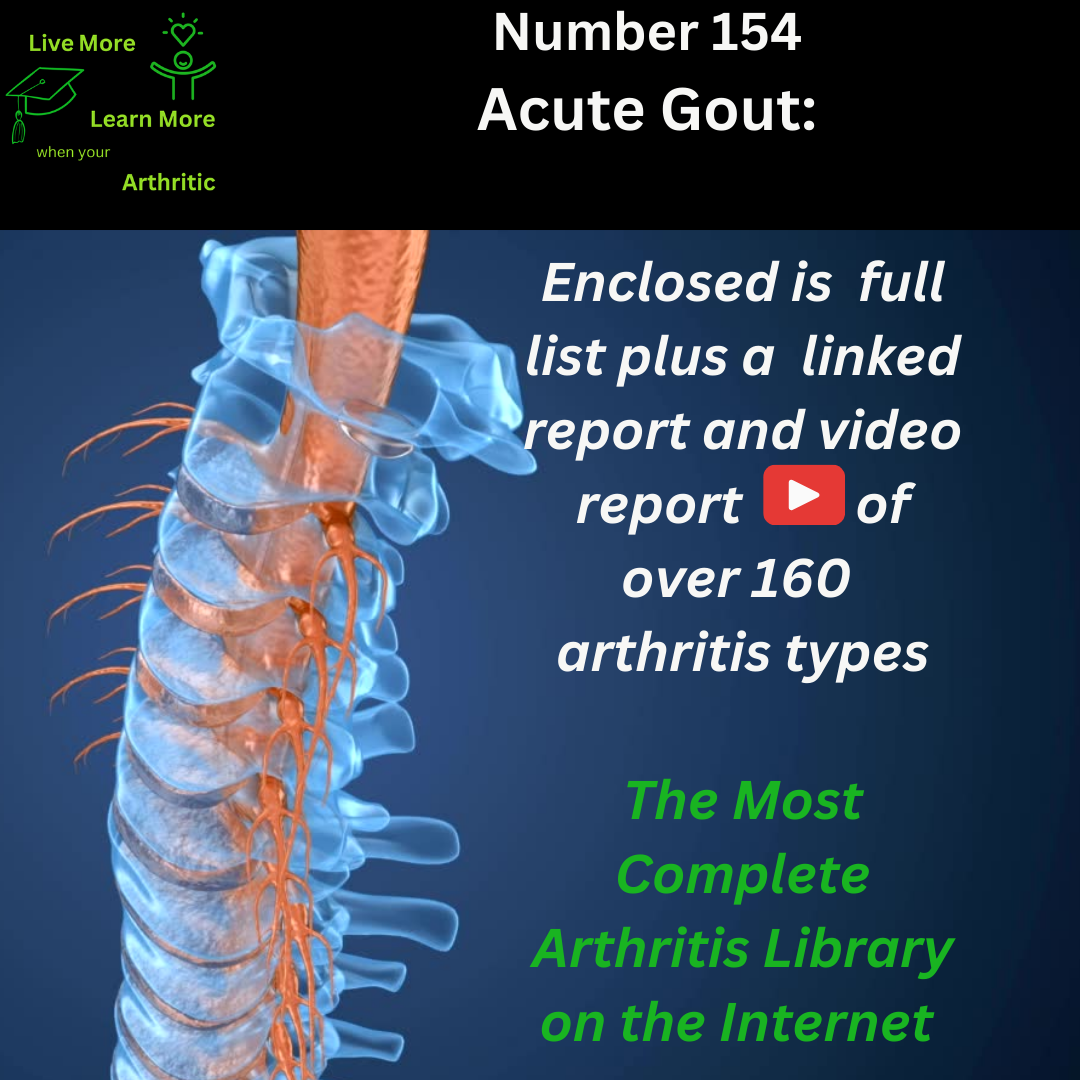
Acute Gout: Number 154 Types of Arthritis
Understanding Acute Gout and its Comorbidities
Acute Gout, characterized by sudden and intense joint pain due to uric acid crystal deposits, can overlap with other forms of arthritis, particularly with conditions like Rheumatoid Arthritis (RA) and Psoriatic Arthritis (PsA). While these conditions have distinct underlying mechanisms, they can coexist in individuals, leading to overlapping symptoms and complications.
Inflammatory Nature of Acute Gout
Acute Gout is considered an inflammatory arthritis due to its association with inflammation triggered by the deposition of uric acid crystals in joints. The presence of these crystals provokes an immune response, leading to redness, swelling, warmth, and pain in affected joints.
Affected Joints and Body Parts
The most commonly affected joint in Acute Gout is the big toe (first metatarsophalangeal joint), although other joints such as ankles, knees, wrists, and fingers can also be involved. The progression typically follows an episodic pattern, with acute flare-ups interspersed with periods of remission.
Remission and Disease Description
Achieving remission in Acute Gout involves managing uric acid levels through dietary modifications, lifestyle changes, and medications. The disease is caused by elevated uric acid levels in the blood, leading to the formation of sharp urate crystals that deposit in joints and surrounding tissues.
Causes and Triggers of Acute Gout
The primary cause of Acute Gout is elevated uric acid levels (hyperuricemia) in the blood, which can result from dietary factors (e.g., high-purine foods), genetic predisposition, or impaired kidney function. Triggers for acute flares include alcohol consumption, dehydration, certain medications (e.g., diuretics), and high-protein diets.
Symptoms and Complications
Symptoms of Acute Gout include sudden and severe joint pain, swelling, redness, and warmth in affected joints. Limited range of motion may occur during flare-ups due to pain and inflammation. Complications of untreated or poorly managed Acute Gout include chronic gouty arthritis, tophi (visible uric acid deposits under the skin), and kidney stones.
Impact on Quality of Life and Longevity
Untreated Acute Gout can significantly impact quality of life, leading to chronic pain, joint damage, and disability. While Acute Gout itself does not typically shorten lifespan, its complications such as kidney disease and cardiovascular events can affect overall health outcomes.
Differences from Primary Arthritis
Acute Gout differs from primary inflammatory arthritis like RA or PsA in its underlying cause (urate crystal deposition), distinct joint involvement patterns, and response to specific treatments targeting uric acid levels.
Interconnected Diseases and Conditions
Acute Gout is often associated with metabolic conditions such as obesity, hypertension, and diabetes, which can exacerbate hyperuricemia and increase gout risk. Understanding and managing these interconnected conditions is essential for comprehensive gout care.
Proactive Management and Complication Prevention
A proactive approach to Acute Gout involves lifestyle modifications (e.g., balanced diet, hydration, weight management), medication adherence (e.g., urate-lowering therapies), and regular monitoring to prevent flares and complications.
Complications of Localized Cutaneous Lupus (LCLE)
Complications of LCLE can include skin damage, scarring, and emotional distress due to visible lesions. Rarely, LCLE may progress to systemic lupus erythematosus (SLE), impacting internal organs and overall health.
Gender and Age Trends
Acute Gout is more common in men, particularly after middle age. However, women can also develop gout, especially after menopause due to hormonal changes. Genetics, lifestyle factors, and diet play significant roles in gout development.
Interconnected Health Risks
Individuals with Acute Gout are at increased risk of developing cardiovascular disease, kidney stones, and metabolic syndrome due to shared underlying factors such as hyperuricemia and inflammation.
In summary, Acute Gout is a complex inflammatory arthritis characterized by sudden and intense joint pain, with potential comorbidities and complications that can impact quality of life and overall health outcomes. Proactive management, lifestyle modifications, and comprehensive care are essential for optimizing outcomes and reducing the risk of long-term complications associated with this condition.

